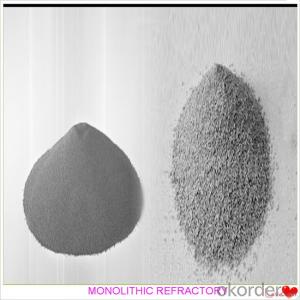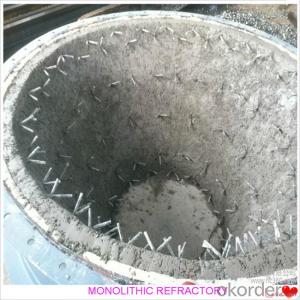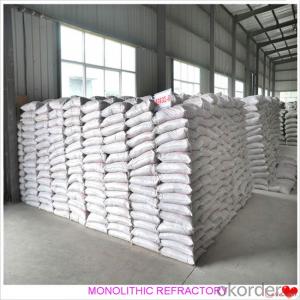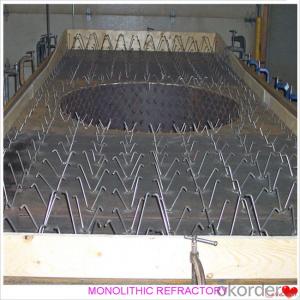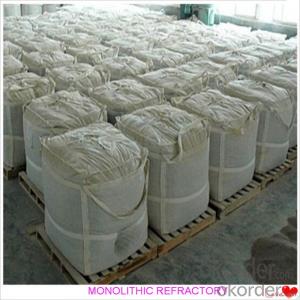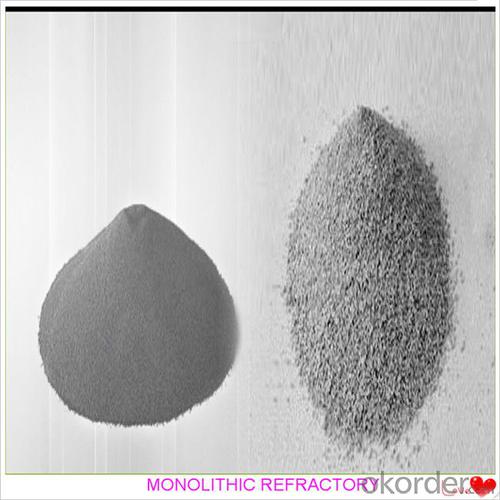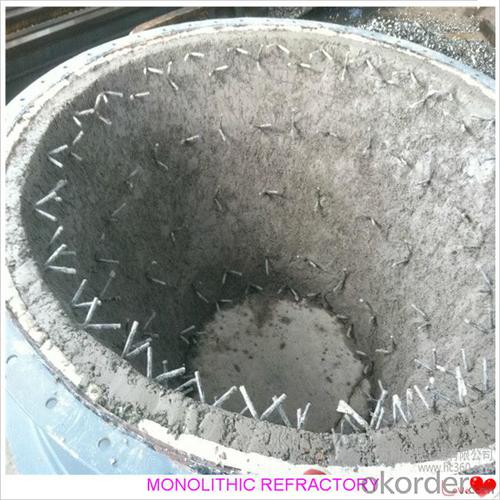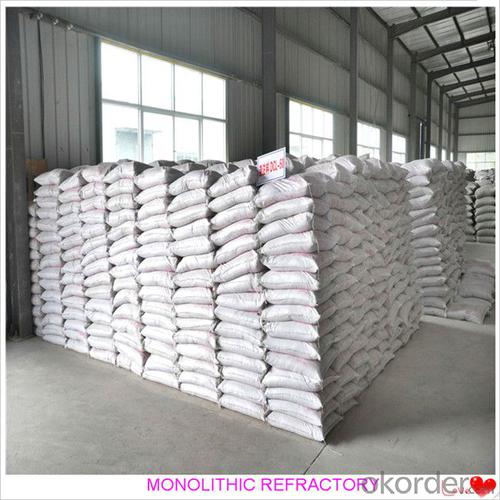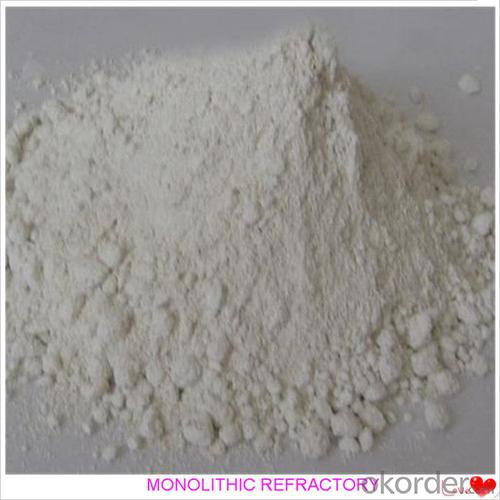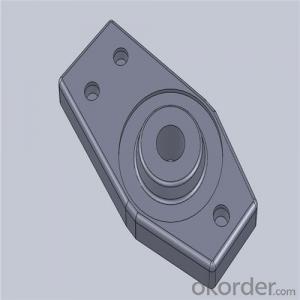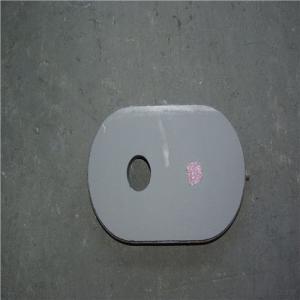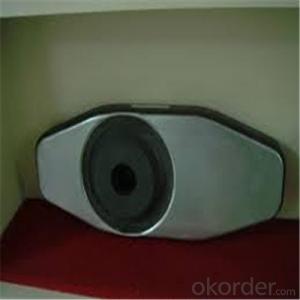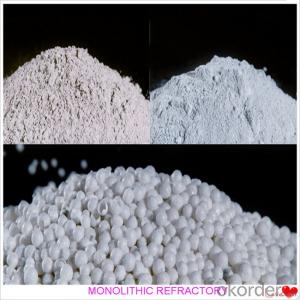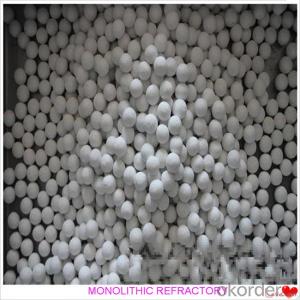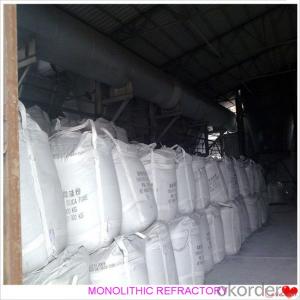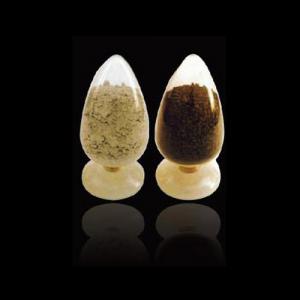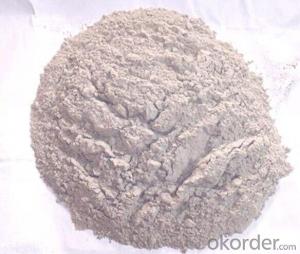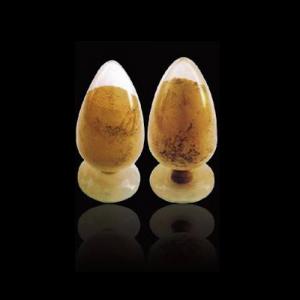Monolithic Refractories for Iron and Steel Industry:Castable Refractory for Fireplace and Industrial Furnace
- Loading Port:
- China main port
- Payment Terms:
- TT or LC
- Min Order Qty:
- 1000 kg
- Supply Capability:
- 3000000 kg/month
OKorder Service Pledge
OKorder Financial Service
You Might Also Like
Castable Refractory for Fireplaces and Industrial Iron and Steel Furnaces
Product Description:
Gunning castable is manufactured according to international standards. The product is famous for its excellent abrasion resistance and low thermal conductivity. Further, these can be provided in different specifications as required by clients. Gunning castables use high purity raw materials and additives as the main material, and are made with superfine powder adding technology.
Product Features:
The material has excellent structural stability and air tightness, and has high physical and chemical properties, and also excellent working ability. If should be used with the same material products.
Product Applications:
Widely used in various kiln linings, such as boilers, blast furnace hot blast stoves, heating furnaces, ceramic kilns, heat treatment furnaces, incinerators, re-circulating fluidized bed furnaces and chemical industry and construction industry furnaces.
Product Specifications:
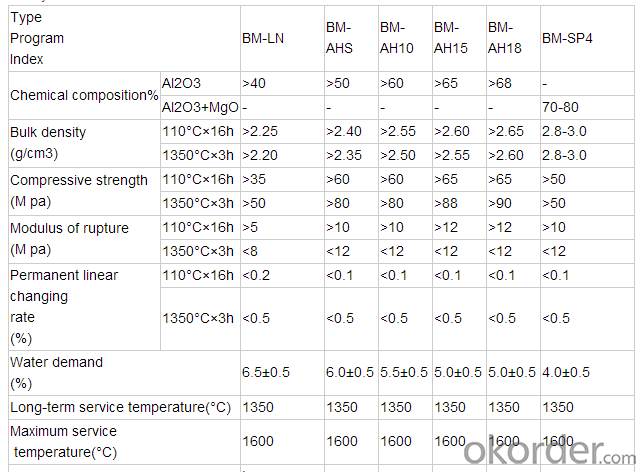
Product Images:
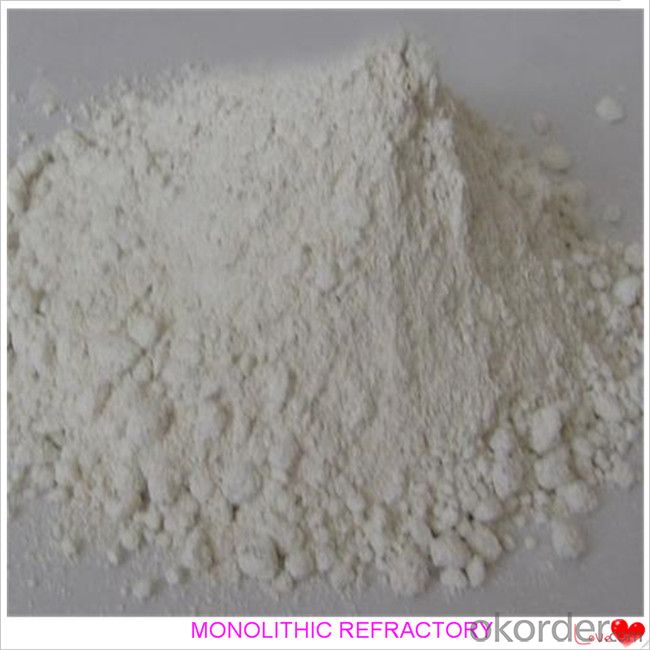
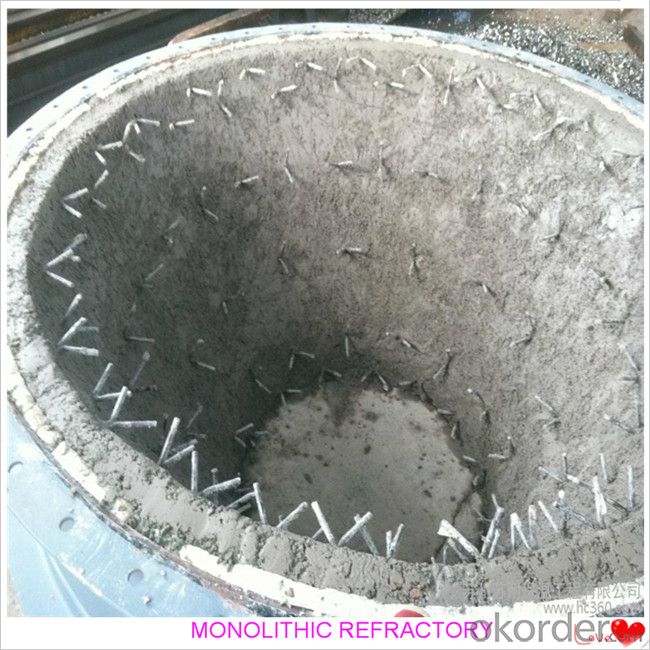
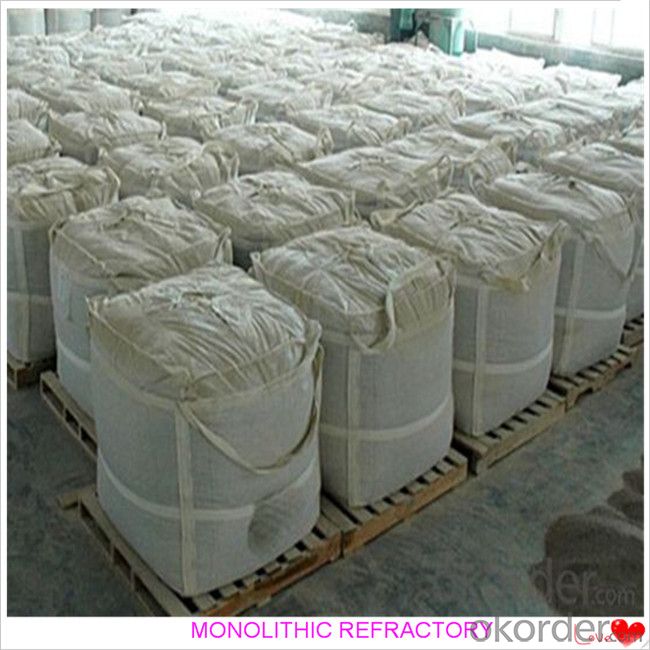
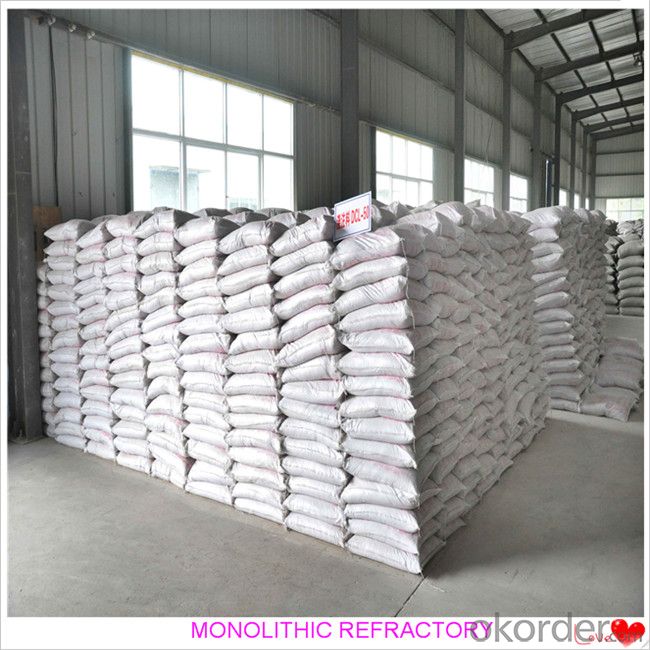
FAQ:
Q1: Why buy Materials & Equipment from OKorder.com?
A1: All products offered by OKorder.com are carefully selected from China's most reliable manufacturing enterprises. Through its ISO certifications, OKorder.com adheres to the highest standards and a commitment to supply chain safety and customer satisfaction.
Q2: How do we guarantee the quality of our products?
A2: We have established an advanced quality management system which conducts strict quality tests at every step, from raw materials to the final product. At the same time, we provide extensive follow-up service assurances as required.
- Q: How do monolithic refractories withstand the corrosive environments in steelmaking processes?
- Monolithic refractories are able to withstand corrosive environments in steelmaking processes due to their unique properties and composition. First and foremost, monolithic refractories are known for their high resistance to temperature and thermal shock. Steelmaking processes involve extremely high temperatures, sometimes reaching up to 1700 degrees Celsius. Monolithic refractories are designed to withstand these extreme temperatures without losing their structural integrity. Additionally, monolithic refractories have excellent chemical resistance. The corrosive environments in steelmaking processes often consist of aggressive chemicals such as molten metal, slag, and gases like carbon monoxide and sulfur dioxide. Monolithic refractories are made from materials that are resistant to these chemicals, preventing them from reacting and causing corrosion. Moreover, monolithic refractories have a dense and homogeneous structure. This helps to prevent the penetration of corrosive agents into the refractory material, further enhancing its resistance to corrosion. The dense structure also minimizes the formation of cracks and fissures, which can act as pathways for corrosive agents to infiltrate the refractory. Furthermore, monolithic refractories are often made from materials with high refractoriness, such as alumina, magnesia, and silica. These materials have high melting points, which makes them more resistant to the extreme temperatures in steelmaking processes. They also have low thermal conductivity, which helps to minimize heat transfer and reduce the risk of thermal damage to the refractory. Lastly, monolithic refractories are often designed with specific additives and binders that enhance their resistance to corrosion. These additives can include materials like zircon, chrome, or graphite, which provide additional protection against the corrosive environment. In conclusion, monolithic refractories withstand the corrosive environments in steelmaking processes through their high resistance to temperature and thermal shock, excellent chemical resistance, dense and homogeneous structure, high refractoriness, and the use of specific additives and binders. These properties and characteristics make monolithic refractories an ideal choice for withstanding the harsh conditions of steelmaking processes and ensuring the longevity and efficiency of the refractory lining.
- Q: How do monolithic refractories perform in ladle lining applications in the iron and steel industry?
- Due to their excellent performance and durability, monolithic refractories are extensively utilized in ladle lining applications within the iron and steel industry. These refractories, which consist of a single material composition, offer numerous advantages over traditional brick linings. One significant benefit of employing monolithic refractories in ladle lining applications is their exceptional resistance to thermal shock. Ladles in the iron and steel industry experience extreme temperature fluctuations during the steelmaking process, including the pouring of molten metal and subsequent cooling. To guarantee the integrity of the ladle lining, monolithic refractories are specifically designed to endure these rapid temperature changes without cracking or spalling. In addition to their thermal shock resistance, monolithic refractories also demonstrate excellent resistance to chemical attack. The lining materials of ladles in the iron and steel industry are exposed to highly corrosive molten metal and slag, which can degrade over time. Nevertheless, monolithic refractories are formulated with high-quality raw materials that provide exceptional chemical stability, preventing the erosion and penetration of corrosive substances. Moreover, monolithic refractories offer superior mechanical strength in comparison to traditional brick linings. This is particularly crucial in ladle lining applications, as the lining must withstand the weight of the molten metal and the mechanical stresses associated with ladle handling and transportation. Monolithic refractories possess excellent load-bearing capabilities, ensuring the structural integrity of the ladle lining even under heavy loads. Another advantage of monolithic refractories is their ease of installation. Unlike brick linings, which require meticulous bricklaying, monolithic refractories can be installed using various techniques, such as gunning or casting. This allows for faster and more efficient lining repairs or replacements, reducing downtime during ladle maintenance. Consequently, iron and steel manufacturers can achieve increased productivity and cost savings. In conclusion, monolithic refractories perform exceptionally well in ladle lining applications within the iron and steel industry. Their resistance to thermal shock and chemical attack, superior mechanical strength, and ease of installation make them an ideal choice for ensuring the longevity and reliability of ladles in steelmaking operations.
- Q: How do monolithic refractories withstand the chemical attacks in aluminum furnace applications?
- Due to its unique composition and properties, monolithic refractories can resist chemical attacks in aluminum furnace applications. These materials are designed to have high resistance to the corrosive effects of molten aluminum and other chemicals found in the furnace environment. To begin with, monolithic refractories are created by combining different minerals like alumina, silicon carbide, and zirconia. These minerals have high melting points and excellent chemical stability. Acting as a barrier between corrosive substances and the underlying structure, they prevent penetration or damage to the refractory lining. Moreover, monolithic refractories typically contain high levels of alumina, which provides exceptional resistance to chemical attacks. Alumina has a strong affinity for oxygen, resulting in the formation of a stable oxide layer on the refractory material's surface. This layer acts as a protective barrier against corrosive elements and reduces the rate of penetration. In addition, monolithic refractories are often designed with a dense microstructure and low porosity. This ensures fewer pathways for corrosive substances to attack the refractory material. The denser the material, the less susceptible it is to chemical attacks. Furthermore, the resistance of monolithic refractories can be further improved by incorporating additives or binders. These additives may consist of organic or inorganic materials that enhance protection against corrosive substances. Overall, monolithic refractories are engineered specifically to withstand the harsh conditions of aluminum furnace applications. Their unique composition, high alumina content, dense microstructure, and resistance-enhancing additives all contribute to their ability to withstand chemical attacks and prolong the lifespan of refractory linings in aluminum furnaces.
- Q: What are the advantages of using insulating castables in the iron and steel industry?
- There are several advantages of using insulating castables in the iron and steel industry. Firstly, insulating castables provide excellent thermal insulation. They have low thermal conductivity, which helps to minimize heat loss from the furnaces and other equipment. This is particularly important in the iron and steel industry, where high temperatures are required for various processes. The insulation provided by castables helps to maintain a stable temperature within the furnace, resulting in improved energy efficiency and reduced fuel consumption. Secondly, insulating castables have high strength and excellent resistance to thermal shock. This is crucial in the iron and steel industry, where extreme temperature changes are common. The castables can withstand rapid heating and cooling cycles without cracking or compromising their structural integrity. This ensures the longevity and durability of the refractory lining, reducing the need for frequent maintenance and repairs. Furthermore, insulating castables are lightweight and easy to install. Their low density makes them easier to handle and transport, resulting in reduced labor costs and shorter installation times. This is particularly advantageous in large-scale iron and steel plants, where time and cost efficiency are critical. Moreover, insulating castables offer good corrosion resistance. The harsh environment in the iron and steel industry, with the presence of molten metal, slag, and various chemicals, can cause corrosion and erosion of refractory materials. Insulating castables are designed to withstand these corrosive conditions, ensuring the longevity of the lining and minimizing the risk of downtime and production disruptions. Lastly, insulating castables are versatile and can be customized to meet specific requirements. They are available in various compositions and densities, allowing for tailored solutions to different applications within the iron and steel industry. This versatility ensures optimal performance and efficiency in various furnace and equipment designs. In conclusion, the advantages of using insulating castables in the iron and steel industry include excellent thermal insulation, high strength, resistance to thermal shock, lightweight installation, corrosion resistance, and versatility. These benefits contribute to improved energy efficiency, reduced maintenance costs, increased durability, and enhanced overall productivity in the industry.
- Q: How do monolithic refractories resist corrosion from molten metals?
- Due to their unique composition and structural properties, monolithic refractories have the ability to resist corrosion caused by molten metals. Typically made from a single material like alumina, magnesia, or silica, these refractories are specifically designed to withstand harsh chemical environments and high temperatures. A significant contributing factor to their corrosion resistance is their dense and compact structure. Through a specialized manufacturing process, monolithic refractories are created with a tightly bonded material that has minimal porosity. This low porosity prevents molten metals from penetrating the refractory and causing damage. Moreover, monolithic refractories often incorporate additives or binders to enhance their resistance to corrosion. These additives, such as silicon carbide, zirconia, or other chemically stable materials, can endure the corrosive effects of molten metals. Additionally, monolithic refractories possess excellent thermal shock resistance. This means that they can endure sudden temperature changes without cracking or spalling. When in contact with molten metals, the refractory's ability to handle thermal shock prevents the formation of cracks or fractures, which would allow further penetration of the corrosive molten metal. In conclusion, the combination of a dense structure, chemical additives, and high thermal shock resistance enables monolithic refractories to effectively resist corrosion caused by molten metals. These refractories find extensive use in various industrial applications, including steelmaking, foundries, and non-ferrous metal processing, where they offer reliable and durable protection against corrosion.
- Q: How are monolithic refractories installed and repaired in iron and steel plants?
- Monolithic refractories play a vital role in iron and steel plants, offering resistance to high temperatures and insulation. They are widely utilized in various applications, including lining furnaces, ladles, and equipment that comes into contact with molten metal. The process of installing monolithic refractories in iron and steel plants typically involves several sequential steps. Initially, the surface where the refractory material will be applied must be prepared, removing any existing refractories or contaminants. This can be accomplished through mechanical means, such as sandblasting, or through chemical cleaning processes. Following this, the monolithic refractory material is mixed with water or a suitable binder to achieve a workable consistency. The resulting mixture is then applied to the prepared surface using a variety of techniques, such as gunning, casting, or troweling. Gunning involves using a high-pressure gun to spray the refractory material onto the surface, while casting involves pouring the mixture into a mold. Troweling is a manual method that entails spreading the refractory material with a trowel. After the application of the refractory material, it must be appropriately cured or dried. This is usually accomplished by allowing the material to air dry or by employing controlled heating. The curing process is imperative to ensure that the refractory material develops the desired properties, including strength and resistance to thermal shock. Regarding repairs, monolithic refractories in iron and steel plants may deteriorate over time due to the harsh operating conditions. When repairs are necessary, damaged or worn-out sections of the refractory lining need to be identified. This can be achieved through visual inspection or non-destructive testing techniques. The repair procedure generally involves removing the damaged refractory material by chipping, drilling, or cutting. The surface is then prepared as previously mentioned, and a fresh batch of monolithic refractory material is applied to reinstate the lining. The repair material must be compatible with the existing lining and provide similar properties to ensure the overall integrity of the refractory structure. It is important to highlight that the installation and repair of monolithic refractories in iron and steel plants necessitate skilled personnel who possess knowledge of refractory materials and installation techniques. Additionally, proper safety precautions should be adhered to in order to safeguard workers from potential hazards, such as exposure to high temperatures, dust, and chemicals. Regular inspection and maintenance are also critical to identify any potential issues early on and prevent major failures that could affect production and safety.
- Q: How do monolithic refractories contribute to the overall efficiency of steel ladle operations?
- The overall efficiency of steel ladle operations can be greatly improved by the use of monolithic refractories. These refractories, which are engineered materials installed as a single structure within the ladle, offer numerous advantages that directly contribute to operational efficiency. One key benefit of monolithic refractories is their exceptional thermal insulation properties. They have a low thermal conductivity, meaning they are effective at retaining and containing heat within the ladle. This insulation helps to maintain the desired temperature of the molten steel, preventing heat loss during transportation and reducing the need for frequent reheating. By minimizing heat loss, monolithic refractories enable a more efficient use of energy resources, resulting in cost savings and improved productivity. Moreover, monolithic refractories possess a high refractoriness, meaning they can withstand high temperatures without losing their structural integrity. This is crucial in steel ladle operations, where extreme temperatures are encountered during the steelmaking process. The high refractoriness of monolithic refractories ensures that they can withstand the intense heat and avoid any damage or failure of the ladle lining. This durability translates into reduced downtime and maintenance requirements, leading to increased operational efficiency. Additionally, monolithic refractories offer excellent resistance to chemical attack. The ladles used in steelmaking come into contact with various corrosive substances, such as molten metals, slag, and fluxes. The chemical resistance of monolithic refractories prevents them from reacting with these substances, ensuring the integrity and longevity of the ladle lining. This resistance to chemical attack reduces the need for repairs and replacements, minimizing downtime and improving overall operational efficiency. Furthermore, the installation of monolithic refractories is relatively quick and straightforward compared to traditional brick linings. This ease of installation saves time and labor costs, allowing for a faster turnaround between ladle operations. It enables steel manufacturers to optimize their production schedules and enhance overall operational efficiency. In conclusion, monolithic refractories play a significant role in improving the efficiency of steel ladle operations. Their thermal insulation properties, high refractoriness, resistance to chemical attack, and ease of installation all contribute to enhanced energy efficiency, reduced downtime, and increased productivity. By choosing to use monolithic refractories, steel manufacturers can achieve optimized ladle performance and ultimately improve their steelmaking process as a whole.
- Q: Can monolithic refractories be used for the lining of reheating furnaces and walking beam furnaces?
- Yes, monolithic refractories can be used for the lining of reheating furnaces and walking beam furnaces. Monolithic refractories are versatile and can be shaped to fit the specific requirements of these furnaces. They offer excellent thermal insulation, high temperature resistance, and durability, making them suitable for withstanding the extreme conditions within these furnaces. Additionally, monolithic refractories can be easily installed, repaired, and replaced, making them a practical choice for lining these types of furnaces.
- Q: What are the typical properties of monolithic refractories used in iron and steel industry?
- Monolithic refractories used in the iron and steel industry typically possess high thermal conductivity, excellent resistance to thermal shock, and high mechanical strength. They are also known for their ability to withstand high temperatures and harsh chemical environments. Additionally, these refractories exhibit good erosion and abrasion resistance, low porosity, and high density, making them ideal for lining furnaces, ladles, and other equipment in the iron and steel production process.
- Q: What are the factors affecting the lifespan of monolithic refractories?
- The lifespan of monolithic refractories can be significantly affected by several factors. 1. Operating temperature is a critical factor. While monolithic refractories are designed to withstand high temperatures, prolonged exposure to extreme temperatures can cause thermal shock and lead to premature failure. 2. Thermal cycling, which refers to frequent temperature fluctuations, can also shorten the lifespan of monolithic refractories. The refractory material expands and contracts, creating stress that can result in cracking and degradation over time. 3. The chemical environment where the monolithic refractories are used plays a crucial role in their lifespan. Exposure to corrosive gases, acids, alkalis, or molten metals can cause chemical reactions that degrade the refractory material. 4. Mechanical stress, such as abrasion, impact, and vibration, can weaken monolithic refractories and reduce their lifespan. This is particularly important in industries with high mechanical activity, such as steelmaking or cement production. 5. Proper installation and regular maintenance are essential for maximizing the lifespan of monolithic refractories. Inadequate installation techniques or neglecting maintenance can result in weak joints, inadequate anchoring, or the growth of cracks, leading to premature failure. 6. The quality and composition of the monolithic refractory material greatly impact its lifespan. Higher-quality materials with better resistance to temperature, chemical attacks, and mechanical stress tend to have longer lifespans. 7. The design of the refractory lining and its engineering considerations, such as thickness, shape, and reinforcement, also influence the lifespan of monolithic refractories. A proper design can distribute stress more evenly, reduce thermal gradients, and improve overall performance and durability. 8. The way monolithic refractories are operated and handled can affect their lifespan. Factors such as rapid temperature changes, improper cooling or heating procedures, or excessive thermal cycling can all contribute to premature failure. In conclusion, various factors such as temperature, thermal cycling, chemical environment, mechanical stress, installation and maintenance practices, quality of refractory material, design and engineering considerations, and operating conditions all impact the lifespan of monolithic refractories. Proper management and consideration of these factors are essential for maximizing their lifespan.
Send your message to us
Monolithic Refractories for Iron and Steel Industry:Castable Refractory for Fireplace and Industrial Furnace
- Loading Port:
- China main port
- Payment Terms:
- TT or LC
- Min Order Qty:
- 1000 kg
- Supply Capability:
- 3000000 kg/month
OKorder Service Pledge
OKorder Financial Service
Similar products
Hot products
Hot Searches
Related keywords
